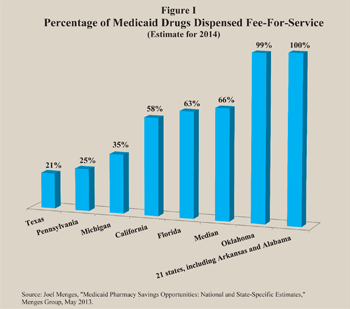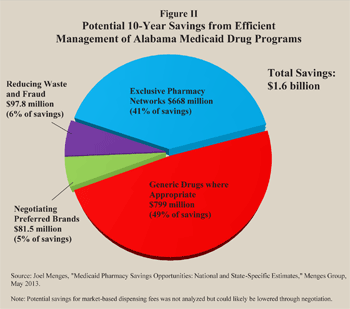Alabama is forging ahead with plans to move Medicaid enrollees into managed care plans. In doing so, the state should change its policies of administering pharmaceutical drug benefits separately from health benefits (called a “carve out”) and reimbursing pharmacies for each prescription filled (called “fee for service”).1
In the past, mandatory drug rebates were only available to state-administered fee-for-service programs, which offset their cost. However, the Patient Protection and Affordable Care Act changed this practice by also allowing rebates for drugs administered through Medicaid managed care plans.2 This has led to increased use of managed drug benefits. Since 2011, the value of prescription drugs dispensed through Medicaid managed care has more than doubled nationwide.3
Virtually all state Medicaid programs distribute some drugs on a fee-for-service basis, but Alabama is among the states that distribute all Medicaid drugs this way.4 [See Figure I.]

The Importance of Medicaid Drug Benefits. Drug therapies often substitute for more expensive surgical treatments and can reduce the need for hospitalizations. Thus, the health plans that provide medical care to Medicaid enrollees are logical entities to manage drug benefits. Medicare pays health plans a set fee per enrollee to provide care, which makes them liable for the cost of nondrug therapies. It stands to reason health plans should also be responsible for drug therapy, given that drugs are often a less costly substitute for surgery or other treatments.
States that administer their own Medicaid drug programs often ignore the benefits of drug therapy coordination and management. Thus, this policy can harm patients.5 For instance, the state of New Hampshire implemented an arbitrary prescription limit on psychiatric drugs in 1990, leading to increased use of emergency mental health services and increased hospitalization of people with schizophrenia. The additional medical costs associated with poor medication management was 17 times greater than the savings from limiting prescriptions.6
By contrast, an analysis of Medicaid managed pharmacy benefits in a number of states by IMS Health found utilization rates for generic antipsychotics and diabetes tended to be higher under managed care than fee-for-service. According to IMS, use of generic versions of antipsychotic medications was 3 percent to 14 percent higher than in fee-for-service Medicaid, on average. Drug utilization for diabetes was also higher in some states studied.7
Moving away from Medicaid fee-based drug programs also increases efficiency. The Lewin Group, a public policy consultancy, found managed drug plans are more cost-effective than plans that administer drugs separately from health benefits.8 Indeed, a Lewin analysis commissioned by Medicaid Health Plans of America, a trade association of managed care providers, found that integrating health plan and drug benefits in 14 states that currently carve out drug benefits would collectively save nearly $1 billion per state, on the average, over a decade.9
The Role of Drug Plan Administrators. Private-sector health plans and state-funded Medicaid managed care plans frequently contract with pharmacy benefit managers (PBMs), private firms that act as third-party prescription drug plan administrators. Private health plans and PBMs use a variety of techniques to control drug costs, including: preferred-drug lists, formularies, mandatory use of mail-order drug suppliers, negotiated volume discounts with drug makers and exclusive contracts with pharmacy network providers.10
Regardless of how the programs are structured, Medicaid enrollees generally obtain their prescriptions at local pharmacies, which are reimbursed for each prescription filled.11 PBMs process and reimburse claims, and negotiate drug prices and rebates with drug manufacturers. They also negotiate dispensing fees – the amount paid to pharmacies for the service of filling a prescription.12
Alabama could benefit from contracting with professional pharmacy benefit managers. Indeed, in June 2013, Governor Robert Bentley established the Medicaid Pharmacy Study Commission to study the potential of better Medicaid pharmacy management.13 The potential savings from well-managed Medicaid drug benefits is substantial.14 A recent analysis by the Menges Group, another consultancy, identified how state Medicaid drug programs lose money.15 For example:
- Prices for drugs often differ unnecessarily from one pharmacy to the next.
- State Medicaid programs arbitrarily pay much higher dispensing fees than would occur in a competitive market.
- State Medicaid fee-for-service drug programs also use low-cost, generic drugs less than efficiently-managed programs.
- Moreover, the number of redundant and unnecessary prescriptions per Medicaid enrollee is often higher for state-managed fee-based drug programs.
As state Medicaid programs across the country place more enrollees in managed care, stakeholders and pharmacy interests have called on state legislators to impose unnecessary regulations on drug plans and the firms that manage drug benefits. They justify these regulations by calling for transparency, claiming that disclosure of negotiated drug prices is necessary to prevent drug plan managers from excessive drug price mark-ups at the expense of patients and health plans. A more likely aim of state drug plan regulation is to protect local pharmacies from competition by hampering many of the methods drug plan managers used to negotiate prices with pharmacies.16
One recent legislative proposal would have handed over control of Alabama’s Medicaid drug program to an organization that represents pharmacy interests. Carefully crafted, but thinly veiled, language inserted in the Alabama House General Fund Budget would have restricted Alabama’s Medicaid drug management to only one firm – a cooperative owned by member pharmacies.17
Placing control over Alabama’s Medicaid drug program in the hands of the pharmacies that provide Medicaid enrollees’ drugs would not save the state money. Rather, competition among firms that administer benefits, along with aggressive price negotiation with pharmacies will more successfully lower costs. Indeed, the author of the Alabama provision later admitted it was designed to protect certain pharmacies – presumably because their profit margins could be reduced if they had to compete against other pharmacies for Medicaid business.18
Community pharmacies often specialize in serving Medicaid beneficiaries and depend on Medicaid dispensing fees for a portion of their livelihood. Small community pharmacists cannot compete on price and efficiency without cutting profitability, so they fight to maintain the status quo. Many pharmacists are small business owners. Thus, state legislators often view them sympathetically when lobbied for protection from competition – especially out-of-state competition. For example, trade associations for small pharmacies advocate laws that discourage cost-efficient, mail-order drug programs commonly found under managed care. Community pharmacists also lobby lawmakers to prohibit drug plan managers from limiting the number of pharmacies in a network, a tactic pharmacy benefit managers sometimes use to negotiate lower drug prices (and dispensing fees) from pharmacies.
For example, many states allow any willing pharmacy to participate in the Medicaid drug program rather than allowing health plans to develop exclusive networks of pharmacies willing to provide lower prices. Any willing pharmacy laws not only reduce the bargaining power of health plans to negotiate lower prices, they also facilitate waste and fraud by requiring Medicaid drug plans to reimburse large networks (with numerous small pharmacies), making it more difficult to detect billing fraud by unscrupulous pharmacy operators.
Potential Savings. According to Menges, better management of Medicaid prescription drug benefits could save Alabama Medicaid $1.6 billion over 10 years ($1.1 billion in lower federal spending and $513 million less in state spending). Specifically, as Figure II shows:

- About half (49 percent) of the savings would come from use of generic drugs where appropriate.
- More than one-third (41 percent) of the savings would come from negotiating steep discounts with exclusive (limited) networks.
- Using preferred brands and better management of waste and fraud would save 11 percent.
The analysis did not estimate savings from paying market-based, competitive dispensing fees. Such a policy would likely further reduce costs – possibly lowering dispensing fees by 80 percent.
Additional Potential Savings. Alabama could also save money by:19
- Increased use of generic drugs. About three-fourths of drug prescriptions in Alabama’s Medicaid program are filled with generics, whereas the national average for managed Medicaid drug benefits is slightly higher – about 80 percent.
- Reduced dispensing fees. Alabama paid pharmacies $10.64 to dispense a prescription in 2011, whereas the national average for private Medicare Part D plans is one-fifth as much – about $2.00. The state has adopted a new formula to reimburse pharmacies for dispensing drugs. But no one knows if the new system will lower costs or raise them.20
- Reduced use of prescriptions. Nationally, the number of prescriptions per Medicaid enrollee is generally higher among enrollees in fee-for-service Medicaid programs compared to managed care.
Conclusion. It is in Alabama taxpayers’ interest to provide drugs to Medicaid enrollees at the lowest possible cost to the state. The governor’s commission – which is due to issue its report in December 2013 – will likely find that employing the services of pharmacy benefit managers will lower costs. However, the commission will undoubtedly come under political pressure to protect local providers from the type of competition that could save Alabama taxpayers money.
Devon Herrick is a senior fellow with the National Center for Policy Analysis.
1. IMS Institute for Healthcare Informatics, “Shifting From Fee-For-Service Medicaid: An Early Review of Rx Drug Utilization,” Health Affairs Blog, April 5, 2013. Available at http://healthaffairs.org/blog/2013/04/05/shifting-from-fee-for-service-medicaid-an-early-review-of-rx-drug-utilization/.
2. In the state Medicaid programs this is called fee-for-service (FFS).
3. Murray Aitken et al., “Shift from Fee-for-Service to Managed Medicaid: What is the Impact on Patient Care?” IMS, Institute for Healthcare Informatics, April 2013.
4. Joel Menges, “Medicaid Pharmacy Savings Opportunities: National and State-Specific Estimates,” Menges Group, May 2013. Available at: http://www.pcmanet.org/images/stories/uploads/2013/final percent20medicaid percent20savings percent20report percent20menges percent20group percent20may percent202013.pdf.
5. For example, see Gerome Wilson, Kirsten Axelsen and Simon Tang, “Medicaid Prescription Drug Access Restrictions: Exploring the Effect on Patient Persistence with Hypertension Medications,” American Journal of Managed Care, Vol. 11, 2005, pages SP27-SP34.
6. Haiden A. Huskamp, “Managing Psychotropic Drug Costs: Will Formularies Work?” Health Affairs, Vol. 22, No. 5, September/October 2003, pages 84-96.
7. Murray Aitken et al., “Shift from Fee-for-Service to Managed Medicaid: What is the Impact on Patient Care?” Institute for Healthcare Informatics, April 2013.
8. Joel Menges et al., “Projected Impacts of Adopting a Pharmacy Carve-In Approach Within Medicaid Capitation Programs,” Lewin Group, February 2011. Available at http://www.lewin.com/content/publications/MHPAPaperPharmacyCarve-In.pdf.
9. The savings was about $12 billion spread among Connecticut, Delaware, Illinois, Indiana, Iowa, Missouri, Nebraska, New York, Ohio, Tennessee, Texas, Utah, West Virginia and Wisconsin. See Joel Menges et al., “Projected Impacts of Adopting a Pharmacy Carve-In Approach Within Medicaid Capitation Programs.”
10. Ibid.
11. Devon M. Herrick, “Increasing the Cost-Effectiveness of Medicaid Drug Programs,” National Center for Policy Analysis, Policy Backgrounder No. 164 by April 29, 2011. Available at http://www.ncpathinktank.org/pdfs/bg164.pdf.
12. Ibid.
13. Brandon Moseley, “Bentley Establishes Alabama Medicaid Pharmacy Study Commission,” Alabama Political Reporter, June 2013. Available at http://www.alreporter.com/al-politics/political-news/state-news/4718-bentley-establishes-alabama-medicaid-pharmacy-study-commission.html.
14. Joel Menges et al., “Potential Federal and State-by-State Savings if Medicaid Pharmacy Programs were Optimally Managed,” Lewin Group, February 2011. Available at http://www.pcmanet.org/images/stories/uploads/2010/12/Medicaid_Pharmacy_Savings_Report.pdf; and Joel Menges et al., “Projected Impacts of Adopting a Pharmacy Carve-In Approach Within Medicaid Capitation Programs,” Lewin Group, February 2011. Available at http://www.mhpa.org/_upload/MHPAPaperPharmacyCarve-In.pdf.
15. Joel Menges, “Medicaid Pharmacy Savings Opportunities: National and State-Specific Estimates,” Menges Group, May 2013. Available at http://www.pcmanet.org/images/stories/uploads/2013/final percent20medicaid percent20savings percent20report percent20menges percent20group percent20may percent202013.pdf.
16. Devon M. Herrick, “Unnecessary Regulations that Increase Prescription Drug Costs,” National Center for Policy Analysis, NCPA Policy Report No. 346, March 07, 2013. Available at http://www.ncpathinktank.org/pub/st346.
17. Kim Chandler, “Speaker’s company picks up economic development, consulting work for Alabama groups,” Birmingham Observer, blog, July 28, 2013. Available at http://blog.al.com/wire/2013/07/speakers_company_picks_up_econ.html.
18. Bill Pritt, “Hubbard Voted to Pass Bill Guaranteeing His Business Client Millions in Medicaid Funds,” Alabama Political Reporter, June 12, 2013.Available at http://www.alreporter.com/al-politics/political-news/state-news/4726-hubbard-voted-to-pass-bill-guaranteeing-his-business-client-millions-in-medicaid-funds.html.
19. Ibid.
20. Adam J. Fein, “NADAC Momentum: California Abandons Average Acquisition Cost for Pharmacy Reimbursement,” Drug Channels, June 13, 2013. Available at http://www.drugchannels.net/2013/06/nadac-momentum-california-abandons.html. Also see Joel Menges, “Medicaid Pharmacy Savings Opportunities: National and State-Specific Estimates,” Menges Group, May 2013. Available at http://www.pcmanet.org/images/stories/uploads/2013/final percent20medicaid percent20savings percent20report percent20menges percent20group percent20may percent202013.pdf.